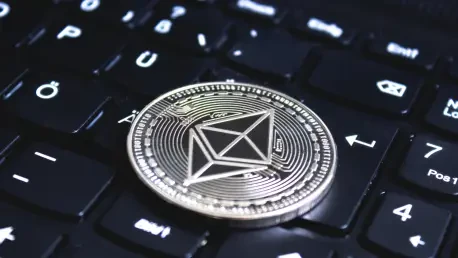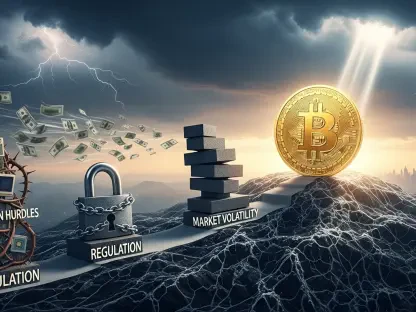In an era where global financial transactions are increasingly critical to economic growth, XRP emerges as a transformative force within the fintech landscape, particularly in the domain of cross-border payments. As a digital asset tied to the Ripple ecosystem, XRP addresses some of the most persistent challenges in traditional banking systems, including exorbitant fees, delayed processing times, and a lack of transparency that often frustrates businesses and individuals alike. By leveraging blockchain technology through RippleNet, XRP offers a streamlined alternative that promises efficiency and cost savings. This article explores the innovative ways in which XRP is reshaping international payments, from tackling systemic inefficiencies to gaining institutional trust through compliance, achieving regulatory milestones, and positioning itself as a cornerstone of future financial infrastructure. The journey of XRP highlights a blend of technological prowess and strategic alignment with global standards, making it a pivotal player in the ongoing digital payments revolution.
Overcoming Barriers in Global Transactions
The inefficiencies embedded in traditional cross-border payment systems have long been a thorn in the side of international commerce, with transactions often taking several days to settle and incurring fees that can reach as high as 6-8% of the transferred amount. XRP, through RippleNet’s innovative On-Demand Liquidity (ODL) service, steps in as a bridging asset that drastically reduces these burdens. By facilitating near-instantaneous transfers at costs frequently below 1%, XRP offers a compelling solution for financial entities seeking to optimize their operations. This capability not only benefits large corporations moving substantial sums across borders but also supports smaller businesses and individuals who rely on affordable remittance services. The stark contrast between the sluggish, expensive legacy systems and XRP’s agile, cost-effective approach underscores its potential to redefine how money moves globally, paving the way for a more inclusive and efficient financial ecosystem.
Beyond the immediate benefits of speed and cost reduction, XRP’s role extends to enhancing transparency and reliability in transactions, addressing another critical pain point of traditional systems. The blockchain technology underpinning XRP ensures that every transaction is recorded on an immutable ledger, providing a clear audit trail that minimizes the risk of fraud or errors. This level of traceability is particularly valuable in regions where financial infrastructure lacks robustness, offering a layer of security that legacy systems often fail to provide. Furthermore, the ability to bypass multiple intermediaries—each of which typically adds time and cost—streamlines the entire process. A practical example lies in transfers between the U.S. and emerging markets, where XRP’s efficiency can transform the experience of sending funds, making it a vital tool for fostering economic connectivity. This multifaceted impact positions XRP as more than just a transactional asset, but as a catalyst for broader systemic change in global finance.
Building Confidence with Standards and Partnerships
RippleNet’s alignment with ISO 20022, a widely recognized global financial messaging standard, has been instrumental in establishing XRP as a trusted solution among financial institutions. This compliance ensures seamless interoperability with banks and payment processors, a critical factor for integration into existing systems. Since adopting this standard, over 400 institutions across diverse regions such as Asia, the Middle East, and Latin America have incorporated RippleNet into their operations. The trust generated by this adherence to global norms allows XRP to serve as a reliable medium for transactions, bridging the gap between innovative blockchain technology and the stringent demands of institutional finance. Such widespread adoption reflects a growing recognition of XRP’s ability to deliver operational efficiencies, solidifying its standing as a preferred choice for modernizing cross-border payment frameworks.
The tangible benefits of XRP’s integration into institutional systems are evident in real-world applications that highlight its transformative potential. Consider a substantial transfer of $10 million from the U.S. to Mexico: using XRP through RippleNet, the transaction completes in mere seconds rather than days, with fees slashed to a fraction of the traditional cost. This efficiency not only saves money but also enables businesses to operate with greater agility, responding to market needs without the delays inherent in legacy systems. The appeal of such outcomes drives further partnerships, as financial entities recognize the competitive edge gained by adopting XRP-driven solutions. This momentum creates a virtuous cycle, where increased usage enhances liquidity and further cements XRP’s role in the fintech space. As more institutions embrace this technology, the foundation for a more interconnected and responsive global payment network continues to strengthen, with XRP at its core.
Navigating Regulatory Waters and Market Opportunities
A significant milestone in XRP’s journey came with a 2025 ruling by the U.S. Securities and Exchange Commission (SEC), which classified XRP as a non-security in secondary markets, providing much-needed clarity for its legal standing. This decision has bolstered confidence among institutional investors, who previously hesitated due to regulatory uncertainty. The ruling opens doors for broader acceptance and integration into mainstream financial products, signaling a shift toward viewing XRP as a legitimate and stable asset. An upcoming development, the anticipated ProShares Ultra XRP ETF expected by October 2025, could further amplify this trend by attracting capital from risk-averse entities like pension funds and endowments. Such progress underscores how regulatory clarity not only validates XRP’s utility but also enhances its appeal as a viable investment vehicle within the evolving fintech arena.
Beyond regulatory achievements, XRP’s unique positioning as both a utility token and a compliant asset creates a compelling case for its long-term market potential. The ability to facilitate efficient transactions while adhering to institutional standards sets it apart from many other cryptocurrencies that struggle with regulatory acceptance. This duality fosters a self-reinforcing dynamic: as more financial entities adopt RippleNet for operational needs, the demand for XRP as a bridging asset rises, boosting its liquidity and market capitalization. Additionally, Ripple’s strategy of burning excess tokens to maintain scarcity adds an element of value preservation, appealing to investors seeking assets with potential for appreciation. These combined factors position XRP as an attractive option for those looking to engage with a digital asset that offers both practical functionality and investment upside, marking it as a standout in the crowded cryptocurrency landscape.
Envisioning a New Era of Digital Payments
As the cross-border payments market is projected to exceed $250 trillion annually by 2030, XRP stands poised to play a central role in meeting the escalating demand for faster, cheaper, and more transparent transactions. Unlike many speculative cryptocurrencies, XRP’s value is deeply rooted in its real-world utility, driven by RippleNet’s ability to combine blockchain agility with compliance to global financial standards. This strategic alignment ensures that XRP remains relevant in an environment where interoperability and regulatory adherence are non-negotiable for financial modernization. The potential for XRP to underpin next-generation financial infrastructure is not merely theoretical but grounded in its proven track record of facilitating efficient transactions across borders, offering a glimpse into a future where digital payments are seamless and universally accessible.
Reflecting on the broader implications, XRP’s evolution suggests a fundamental shift in how financial systems might operate in the years ahead. Its capacity to address systemic inefficiencies while maintaining institutional trust positions it as a linchpin in the ongoing fintech revolution. The strategy of token scarcity, coupled with expanding adoption, hints at sustained relevance as a potential store of value alongside its transactional role. For stakeholders in the financial sector, the rise of XRP presents an opportunity to rethink traditional models and embrace digital solutions that prioritize efficiency and inclusivity. Moving forward, the focus should be on fostering further partnerships and navigating evolving regulatory landscapes to maximize XRP’s impact. As the industry continues to transform, staying attuned to technological advancements and market needs will be crucial in ensuring that solutions like XRP drive meaningful progress in global payments.









